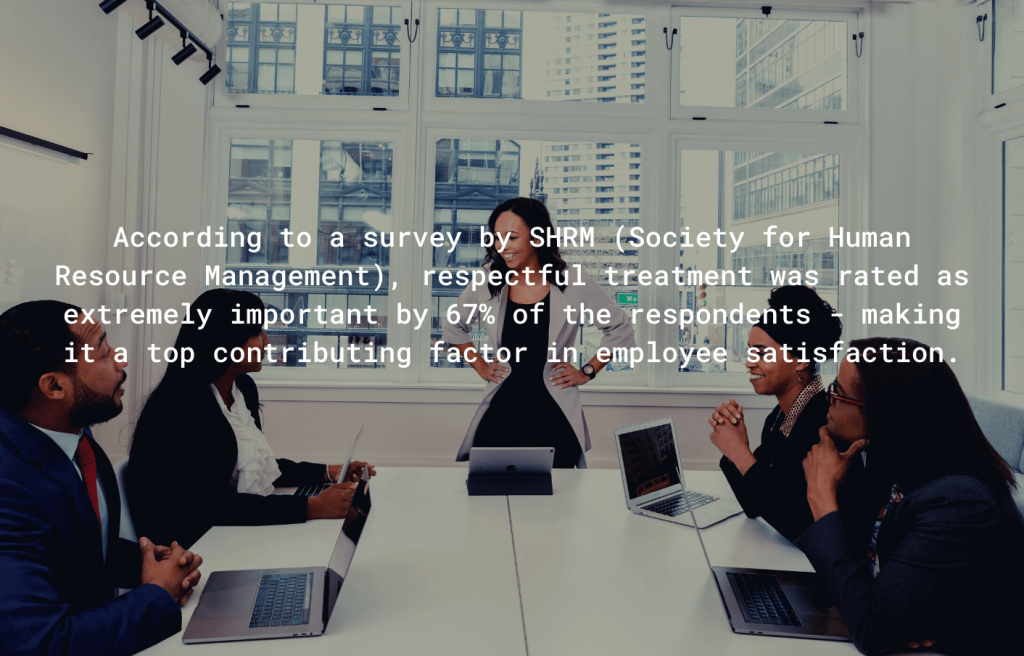When it comes to workplace satisfaction, most employees today (especially millenials) want more than just “satisfactory”.
First, what is satisfaction in the workplace? Well, it used to denote how satisfied employees are with their wages and working conditions. As we know now, these aspects are crucial – but they are not enough to sustain employee engagement or passion. That’s why work satisfaction has now expanded to include the factors which we shall talk about shortly.
By understanding these factors, organizations can improve the overall satisfaction levels of their employees. So, what are the factors that drive employee workplace satisfaction?
What causes workplace satisfaction?
Herzberg’s two-factor theory states that two factors contribute to an employee’s satisfaction at work. They are:
- Motivator factors: Factors such as appreciation, career opportunities and performance.
- Hygiene factors: Factors like the salary, relationship with teammates and the physical workplace.
Herzberg’s theory proposes that if an employee is dissatisfied, it often has something to do with the hygiene factors. On the other hand, an employee’s satisfaction comes from the motivator factors.
In other words, increasing an employee’s wages (a hygiene factor) does not mean that the employee is satisfied. It only means that she is no longer dissatisfied. Appreciating what she does, and promoting her to a position of responsibility – that will increase her satisfaction.
Another way we can put this, is that hygiene factors are the basic needs that must be taken care of first. Then we move on to the motivator factors – the ones that lead to true employee satisfaction.
What are the 5 factors of job satisfaction?
Here are the top 5 factors that drive work satisfaction:

1. Employee appreciation & respect
When was the last time you felt appreciated in your workplace? How did it make you feel?
Employees thrive on regular appreciation. It recognizes the fact that success is often due to the efforts of other employees as well, and reinforces the importance of teamwork.
Appreciation comes in various forms.. Some employees prefer a formal recognition in front of their teammates, while others would like a good word in private. Recognition and showing gratitude are one of the many ways by which we can build strong work relationships.
Apart from appreciation, another factor that often gets overlooked is respect. Initiating constructive feedback and an open culture in the workplace is a great way to encourage respect between employees. Here’s an employee workplace satisfaction survey created using SurveySparrow..
To create similar employee satisfaction surveys, workplace happiness surveys or employee engagement surveys, you can sign up for free.
14-day free trial • Cancel Anytime • No Credit Card Required • No Strings Attached
2. Career progression
A clear career path for an employee is a significant enabler of workplace satisfaction.
Career progression goes beyond training and learning programs. Employees of today are also looking for clear-cut career development opportunities that involve a path of progression.
One way to meet these needs is to have yearly or quarterly 360 degree feedback reviews. Using 360 feedback software like SurveySparrow, you can collect data from multiple sources about each employee’s strengths weakness and blind spots.
Based on the feedback, chart personalized development plans for each employee. Then follow up with 1:1 conversations to ensure that each plan is on track.
Once the employee reaches a certain level of confidence in their job role, they can get more autonomy in their work and the freedom to pursue their ideas.
By providing them with wider opportunities to excel – either in the form of a promotion or a horizontal job rotation – you can make them feel re-invigorated to learn new skills and explore different avenues.
3. Work-life balance
Work-life balance is defined as the fine division between different sections of a person’s life like work, family, and friends.
Striking a balance between both is what many employees struggle to do. Constantly working, without any breaks in between, results in frustration and isolation. On the other hand, not getting enough work done prevents employees from progressing within their work role.
Organizations should understand the importance of creating a culture with a work-life balance. This leads to better work satisfaction, higher retention rates and a greater pool of top talent across the industry.
As more people adjust to working remotely, the fine line that used to exist between the office and home has become blurred. It seems that we are working longer hours, burning out more and struggling to unplug from work.
Organizations can take measures to improve work-life balance by keeping meetings short, on-topic and cancelling unnecessary ones. Collaborate with your team to find the root causes of the work-life imbalance, and take their help for implementing strategies to improve it. You can also implement automatic logouts, tele-health consultations and wellness check-ins.
4. Positive company culture
We have all heard of the phrase “Culture eats strategy for breakfast.” A famous quote from Peter Drucker, a renowned writer and management consultant.
He stressed that to drive changes in your company, the people behind it have to coordinate as well. If they are dissatisfied or apathetic, then the strategies won’t work. Therefore, it is crucial to cultivate a positive company culture, one that is conducive for work satisfaction.
Company culture is also referred to as corporate culture and workplace culture. But they all mean the same – a set of shared values cultivated deliberately or accumulated over the years.
The three pillars of great company culture are Diversity, Inclusion and Equality. All employees should be treated equally, and inclusion should be a high priority. By creating an inclusive workplace we develop a positive work culture where they feel comfortable to voice their opinions.
The foundation for these pillars is empathetic leadership. People at the helm of the leadership team should be individuals who can easily put themselves in other people’s shoes, and enable them to thrive, not just survive.

5. Meaningful work
People spend one-third of their lives at work. Their jobs are often the focal point of their lives. The feeling that their work is meaningful, positively affects the company, and that they are valuable assets in their workplace motivates them to stick on.
Today’s workforce wants more from their career. Much more than a source of income, employees now view their careers as a source of meaning. Reports back this up – employees who feel they do meaningful work put in more effort than those who feel their job is meaningless.
The result: increased employee engagement and higher workplace satisfaction.
Take steps to ensure that every employee feels connected to their work they perform. Employees should have a clear perception of why they are essential for the company, and should be able to connect the company’s success with their own. The best place to start is from the employee onboarding stage itself. Then, follow it up with regular feedback at each stage of the employee journey for the best results.
Related: How HR chatbots help employee onboarding
Wrapping Up
Satisfied employees play a key role in your business well-being. They tend to be more productive, boost the team’s morale and are more likely to come up with innovative ideas. In short, workplace satisfaction is an important metric that indicates the overall health of an organization.
In this article, we have talked about the 5 main drivers of employee satisfaction. But there could be more – depending on your business model, team size, and industry. Consider sending surveys to measure employee pulse and trends. Then, use that data to understand what drives your employees, and transform your company into one of the best places to work.







